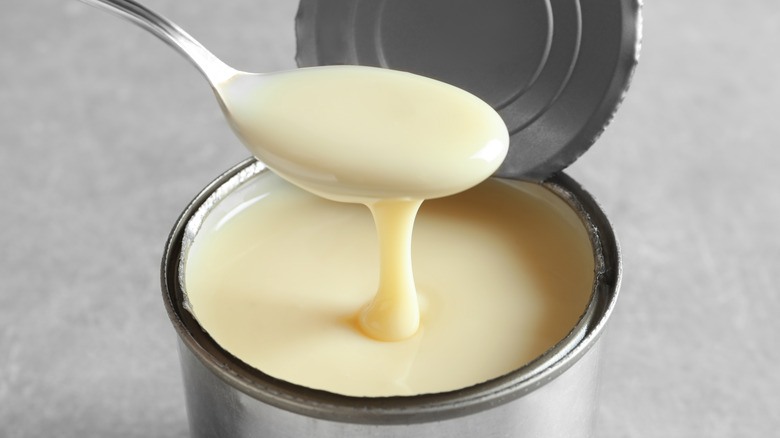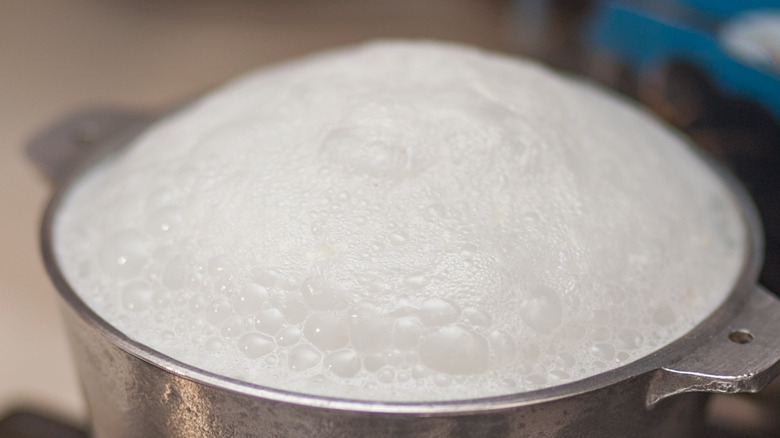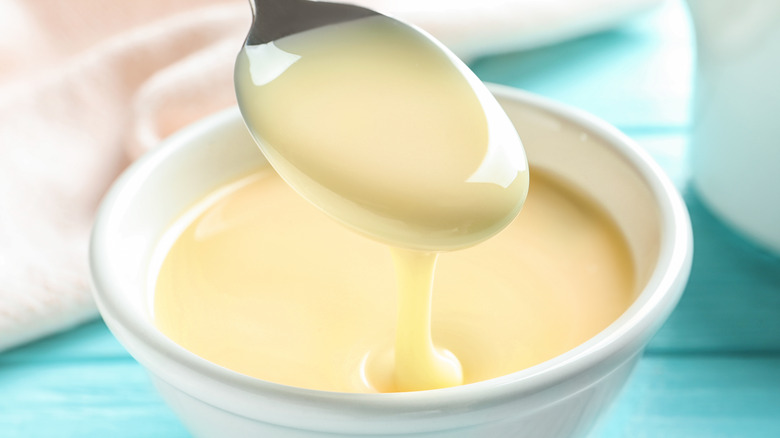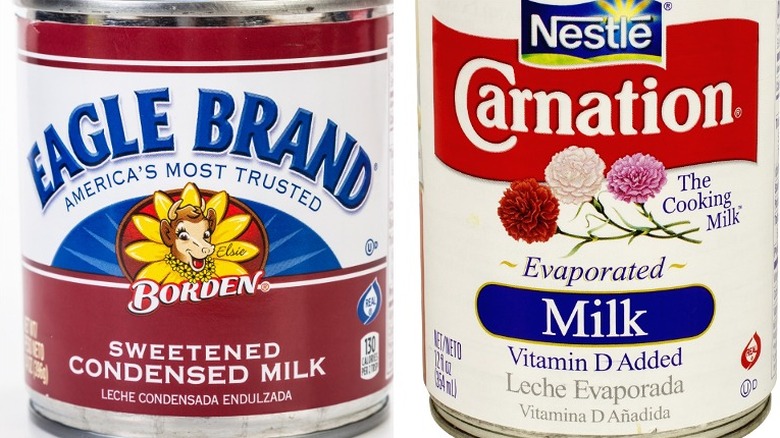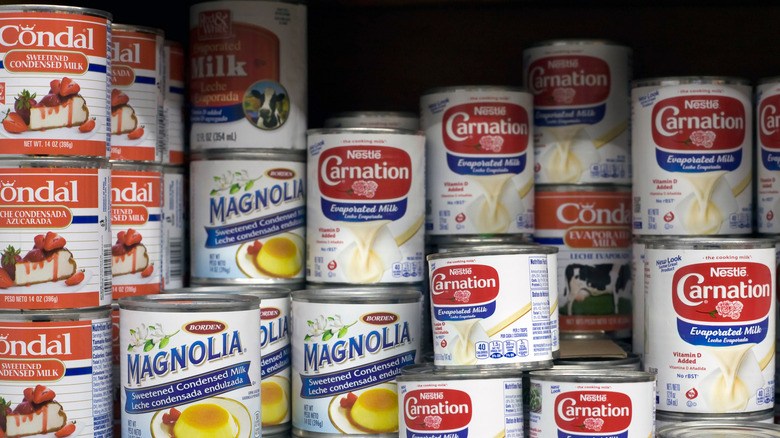What Is Condensed Milk And Is It Nutritious?
Milk is a seemingly simple enough ingredient to come across in a recipe, until you realize that what the recipe is actually calling for is condensed milk. You might be wondering what that means — condensed as in smaller? Stronger? — or maybe your recipe calls for sweetened condensed milk, and you're not sure if that's the same thing at all. Let us explain.
According to The Kitchn, condensed milk and sweetened condensed milk are indeed the same thing: Both are a thick, sweetened, and creamy kind of shelf-stable milk used in a number of dishes. The dual names creates confusion because it implies that there is a unsweetened version of condensed milk, but this is not true. (Actually, canned milk without sweeteners is sold as evaporated milk.)
Put simply, condensed milk has had more than half of its water removed before the sugar is added in. It's a popular ingredient in sweet drinks, desserts, and used to make sauces like dulce de leche. Sold in small cans, condensed milk is a great ingredient that's easy to keep on hand, and it's worth learning more about for the next time it comes up.
How is condensed milk made?
So how does regular milk turn into this thick, sweet, condensed milk? The process is one that's actually been around for more than 150 years! According to MadeHow, the process starts with regular milk that's been heated and then piped into an evaporator (a machine that uses vacuum evaporation to lower the boiling point of the liquid). Under high pressure, the evaporator removes enough water to leave behind 30-40% milk solids. This process concentrates the milk without changing the flavor (the way caramelization does). Once the milk is concentrated, sugar crystals are injected into the liquid, which sweetens the milk and also acts as a preservative. It's then sealed into cans and labeled for sale.
Dairy farmer Gail Borden first got the idea for preserving milk in 1852, after taking a long sea voyage where supplies quickly ran out or spoiled, adds MadeHow. Once home, he experimented with boiling out some of the water content of milk, condensing it to give it a longer shelf life. The process was patented, and the product got a big boost during the Civil War when condensed milk was distributed in rations to soldiers. Near the end of the 19th century, a Texas grocer had the idea to can condensed milk to prevent spoilage and make it last even longer. All this time later, condensed milk continues to be packaged and sold in cans today.
What does condensed milk look and taste like?
When you compare condensed milk side-by-side with regular milk or even evaporated milk, it's easy to see the difference. For one thing, it's pale yellow in color. However, the most noticeable feature, according to The Kitchn, is that condensed milk is thick with a syrupy consistency similar to that of a jarred caramel sauce.
Sugar makes up almost half the profile of condensed milk — so it comes as no surprise that this stuff is really sweet! Serious Eats shares, however, that while sweetened condensed milk has been heated during processing, it isn't caramelized. That's why it's pale in color and not brown. It may have subtle flavor notes of caramel depending on the brand, but in general it has a very milk-forward flavor — and may also have a slight saltiness.
In their taste test of various brands of condensed milk, Serious Eats also noticed that there are subtle differences between them in sweetness, viscosity, and richness of flavor. They also shared that condensed milk is glossy, and although thick, it's not overly sticky.
Condensed milk vs. evaporated milk
According to The Kitchn, both evaporated and condensed milk go through the same initial process that heats the liquid and then vacuum-evaporates out some of the water. The difference is that evaporated milk stops there: It's just milk that has had around 60% of its water removed to make a concentrated version. The resulting milk is creamier, may have a slightly tan color, and will have similar liquid texture as that of regular milk. It's sold in whole, low-fat, and skim versions.
Condensed milk goes a step further than evaporated in that it's infused with sugar to sweeten and preserve it. It's thick, has a yellowish color, and is very sweet. The Spruce Eats notes that condensed milk is available in low-fat and fat-free varieties. These differences between condensed milk and evaporated milk, both in sweetness and viscosity, means that they cannot be substituted for one another in most recipes.
While recipes might be clear in calling for either condensed milk or evaporated milk, things can get confusing once you get to the grocery store. Both types are sold in cans that are similar in look and size, according to The Kitchn, and they're often stocked near each other, making it all too easy to grab the wrong one! Check the labels carefully, and remember when looking at the ingredient labels, that only condensed milk will have added sugar.
How to cook with condensed milk
According to The Kitchn, the creamy sweetness and unique milky flavor of condensed milk makes it a versatile ingredient to use in baked goods, drinks, and desserts. One favorite hack is to turn condensed milk into a seductively rich dulce de leche sauce by gently boiling the unopened can in water for about an hour. It cooks into a thick caramel sauce right in the can. Condensed milk is also the sweet ingredient in the spice-infused Thai iced tea, and can be used to sweeten hot or cold coffee. A classic Tres Leches cake is soaked with three kinds of milk, including sweetened condensed milk, to give it a custardy texture. If you want to try The Kitchn's home recipe for the trendy Rolled Ice Cream, sweetened condensed milk is key to getting a smooth, creamy texture that rolls without cracking.
Food52 likes to used condensed milk in a batch of sweet cornbread, or to make custard pies, and even to sweeten macaroons. They also recommend trying the Puerto Rican drink coquito, a rich, coconut-flavored beverage sweetened with condensed milk. Bon Appétit keeps their condensed milk love simple by drizzling it right out of the can over a bowl of sliced fruit, or a slice of toast spread with peanut butter. They also point out that condensed milk can be used in savory dishes, too, such as marinades for pork or chicken skewers.
Where to find condensed milk
When you're at the store looking for condensed milk, your best is to head to the baking aisle, according to Info Grocery. Condensed milk is sold in cans and is usually stocked near the sugar, by other canned baking products like pie filling — or with other shelf-stable dairy products like powdered milk and evaporated milk. This is important to remember because The Kitchn says that cans of evaporated milk and condensed milk look very similar in size and labeling, too, and it's easy to grab the wrong one. Brands of condensed milk, according to Serious Eats, include Borden, Carnation, Magnolia, Parrot, and Santini. La Lechera is a brand of condensed milk from Nestlé (they also are the parent brand of Carnation) that you may see in the international aisle of your store.
You can also find recipes online for making homemade sweetened condensed milk: The version from Spruce Eats comes together in a blender using nonfat dry milk, sugar, butter, and boiling water. Another recipe shared on Serious Eats makes a condensed milk that's "thicker, creamier, and more luscious" than store-bought versions. Cooked in a saucepan, it consists of milk, heavy cream, and vanilla bean, plus toasted sugar to give it mild notes of caramel.
Nutritional information about condensed milk
While it does begin as pure, bone-building milk, the large amount of sugar added in condensed milk may tip the scales against any nutritional benefits. According to Nutritionix, one ounce (about two tablespoons) of condensed milk has 90 calories and 49 milligrams of sodium. It contains 3.3 grams of fat — most of this is saturated fat, enough to equal 11% of the daily recommended allowance. Healthline shares that one ounce of condensed milk also has 15 grams of sugar — some of this is the naturally-occurring sugar found in milk, but it's mostly from the sugar added during processing. Given that the American Heart Association recommends no more than 36 grams of sugar daily for men, and 25 grams daily for women, you can see how loaded condensed milk is with the sweet stuff.
Because condensed milk is made from real milk it does have some nutritional plusses, like 2.2 grams of protein, 8% of the recommended daily amount of calcium, and nutrients like phosphorous and vitamin B12 in every serving. Healthline notes that the protein and nutrients make condensed milk a more nutritious choice for people who need to gain weight, rather than products that consist of sugar only. However, for people trying to lose weight, the high calorie and sugar counts negatively outweigh the nutritional benefits, so as with other sugary products, it's best to use condensed milk only for an occasional treat. Those who are lactose-intolerant and avoiding dairy products may also need to strike condensed milk from their list.
